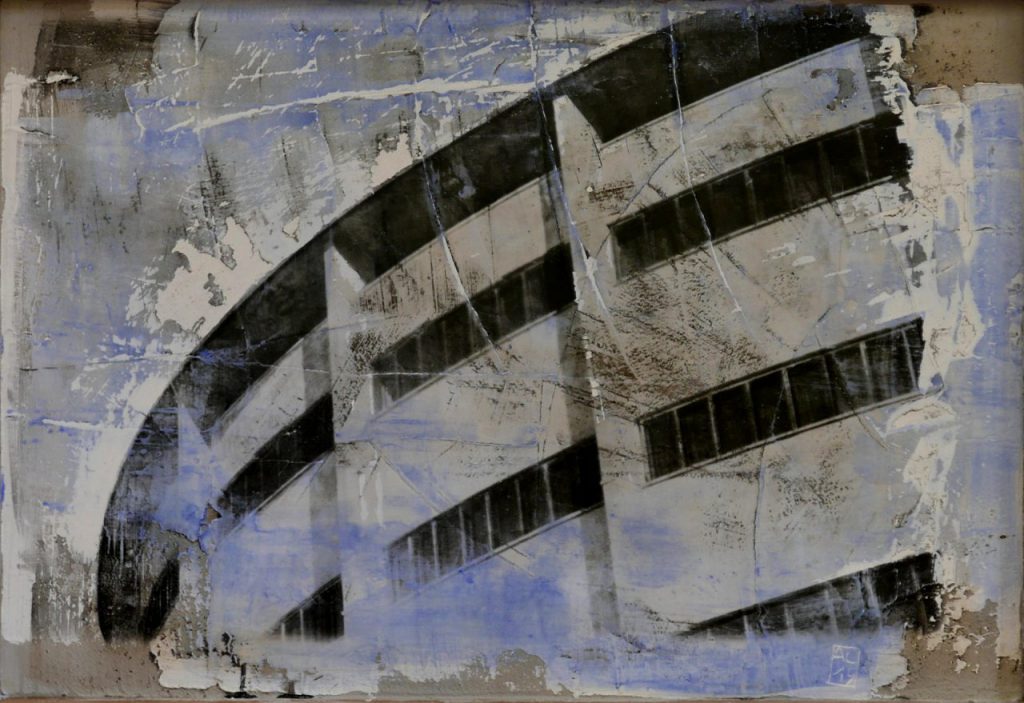
RAW – RomeArtWeek
RomeArtWeek
Open Studio
ANDREA CAPANNA
22/26 ottobre 2019
“Come lavoro con i colori, i pennelli e le tele,
lavoro con la luce, i pezzi di vetro e la chimica”
Man Ray, 1967
Nell’ambito della quarta edizione di RAW – Rome Art Week, 21-26 ottobre 2019 – Andrea Capanna apre le porte di UOL, il suo studio d’arte, situato dove il quartiere del Pigneto si sovrappone a quello di Torpignattara.
In questa occasione l’artista presenta le sue Rovine Urbane, alcune delle quali sono state già precedentemente esposte la scorsa primavera nella galleria romana 28 PIAZZA DI PIETRA.
Le Rovine Urbane proseguono – nelle tecniche e nelle tematiche – la ricerca già messa a punto dall’artista nei Muri. E la accompagnano verso un’evoluzione ulteriore. I Muri possiedono una doppia natura in quanto raffigurano sia vedute cittadine sia ritratti e sono realizzati attraverso una stratificazione ottenuta per via di ‘mettere’ e ‘levare’. Su un supporto di legno l’artista deposita cemento, calce, sabbia, intonaco e colore, ma intervallandone la sedimentazione e lavorando i materiali con carta vetrata, spatole e spazzole d’acciaio, oltre che con altri agenti. Da questo palinsesto contemporaneo emerge progressivamente un’immagine mineralizzata che si sostanzia e si ricompone alla vista mediante i suoi pieni e i suoi vuoti.
Le Rovine Urbane mostrano anch’esse dei lacerti di vedute di Roma. Si tratta di vere e proprie vedute e non d’immagini panoramiche perché Andrea Capanna stabilisce a monte che cosa mostrare e lo fa sovrapponendo due livelli di visione. Infatti, prima seleziona l’oggetto urbano secondo un’angolazione ben definita; poi, anche quell’oggetto lo restituisce alla visione solo parzialmente. In questa serie di opere l’artista muove da un’immagine fotografica riportata sul supporto mediante esposizione dello stesso ai sali d’argento. Senza indulgere sulle tecniche – e per evitare di trasformarle in tecnicismi – si può dire che egli si è appropriato di modalità anche obsolete del fare arte, le ha mixate, ma pure reiventate. Al punto che il suo muro di cemento ricreato sul legno – si tratta di ‘quadri’ di medie dimensioni – diventa una superficie impressionabile e impressionata.
Inoltre, allo stesso modo dei Muri, le Rovine esibiscono una natura archeologica, dove per archeologia s’intende l’attitudine allo scavo come scoperta, oltre che l’attività di estrarre frammenti di una realtà sedimentati nel tempo. E la volontà di restituire loro un contesto, seppure precario o mutevole. Pure, data proprio la loro latente origine fotografica, esse appaiono come ombre di una città dimenticata eppure presente attraverso la sua magniloquenza, liminari poiché poste sul labile confine tra il centro e la periferia. Sono tracce di una città che resiste e riemerge attraverso le manovre con cui alcuni uomini intervengono ponendo un freno all’erosione operata dal tempo. Nello specifico, la città riemerge grazie all’aiuto della messa a fuoco operata dall’artista, nonché dalle sue incursioni pittoriche sulle superficie. In questo senso allora le Rovine di Andrea Capanna sono certamente urbane, ma anche irrimediabilmente umane!
Giorgia Terrinoni
“Just as I work with paints, brushes and canvas,
I work with light, pieces of glass and chemistry”
Man Ray, 1967
As part of the fourth edition of RAW – Rome Art Week, October 21-26, 2019 – Andrea Capanna opens the doors of UOL, his art studio, located where the Pigneto district overlaps with that of Torpignattara.
On this occasion, the artist presents Urban Ruins, a collection of artworks some of which were exhibited last spring in the Roman gallery 28 PIAZZA DI PIETRA.
The Urban Ruins continue – in techniques and themes – the research already developed by the artist in The Walls and bring it to further evolution. The Walls have a dual nature in that they depict both city views and portraits and are made through a stratification obtained by “adding” and “removing”. On a wooden support, the artist lays down cement, lime, sand, plaster and color, alternating sedimentation and working with sandpaper, spatulas and steel brushes, as well as with other agents. From this present-day approach, progressively through the alternation of full and empty spaces a mineralized image emerges.
The Urban Ruins also show fragments of Rome landscapes. Actually, these are real views more than panoramas, since Andrea Capanna first decides what to show and then by superimposing two levels of vision, he progressively reaches the final result. In fact, once the urban object has been chosen on the basis of a well-defined angle he then returns the object to vision but only partially.
In his series of works, the artist starts from a photographic image which is revealed on the support by silver salts exposure. Without indulging in technicalities – we would rather say that he has adopted even somewhat obsolete ways of making art, has blended them in and has finally reinvented them to the point that the concrete wall he recreates on wood – in his medium-sized “paintings” – turns into an impressionable and impressed surface.
Moreover, in the same way as the Walls, the Ruins exhibit an archaeological nature, where by archeology we mean the use of excavation as a discovery tool, as well as the activity of extracting fragments of an ancient world and the idea to fix them back in a framework, albeit a precarious or variable one. Yet, exactly because of their latent photographic origin, these artworks appear as shadows of a forgotten and yet thanks to its greatness still alive city while at the same time they seem liminal as they are placed on the fragile border between center and periphery.
They are traces of a city that still resists and surfaces again thanks to the activities of some men who are able to put a brake on the time triggered erosion. More explicitly, the city comes back into view as a result of the artist’s focus, as well as of his pictorial incursions on the surfaces. With this regard then the Ruins of Andrea Capanna are certainly urban, but also hopelessly human!
Giorgia Terrinoni